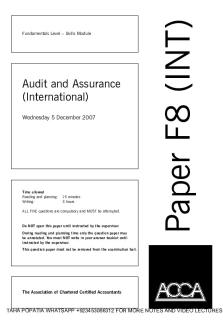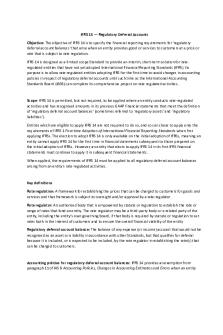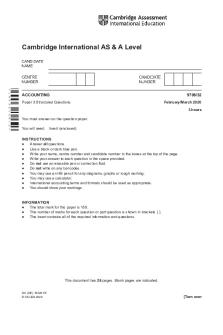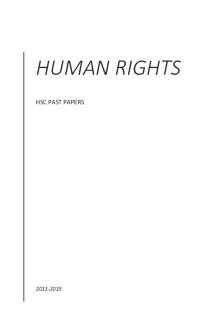acca sbr past papers practice PDF

| Title | acca sbr past papers practice |
|---|---|
| Course | business strategy |
| Institution | University of Manchester |
| Pages | 49 |
| File Size | 1.7 MB |
| File Type | |
| Total Views | 188 |
Summary
Download acca sbr past papers practice PDF
Description
ACCA SBR Tricky Questions (Definitions Highlighted) Ques%on 1 : The acquisi+on of bonds On 1 July 20X5, Banana acquired $10 million 5% bonds at par with interest being due at 30 June each year. The bonds are repayable at a substan+al premium so that the effec+ve rate of interest was 7%. Banana intended to hold the bonds to collect the contractual cash flows arising from the bonds and measured them at amor+sed cost. On 1 July 20X6, Banana sold the bonds to a third party for $8 million. The fair value of the bonds was $10·5 million at that date. Banana has the right to repurchase the bonds on 1 July 20X8 for $8·8 million and it is likely that this op+on will be exercised. The third party is obliged to return the coupon interest to Banana and to pay addi+onal cash to Banana should bond values rise. Banana will also compensate the third party for any devalua+on of the bonds. Discuss how the derecogni%on requirements of IFRS 9 Financial Instruments should be applied to the sale of the bond including calcula%ons to show the impact on the consolidated financial statements for the year ended 30 June 20X7. Solu%on: IFRS 9 Financial Instruments requires that a financial asset only qualifies for derecogni+on once the en+ty has transferred the contractual rights to receive the cash flows from the asset or where the en+ty has retained the contractual rights but has an unavoidable obliga+on to pass on the cash flows to a third party. The substance of the disposal of the bonds needs to be assessed by a considera+on of the risks and rewards of ownership. Banana has not transferred the contractual rights to receive the cash flows from the bonds. The third party is obliged to return the coupon interest to Banana and to pay addi+onal amounts should the fair values of the bonds increase. Consequently, Banana s+ll has the rights associated with the interest and will also benefit from any apprecia+on in the value of the bonds. Banana s+ll retains the risks of ownership as it has to compensate the third party should the fair value of the bonds depreciate in value. It would be expected that, if the sale were a genuine transfer of risks and rewards of ownership, then the sales price would be approximate to the fair value of the bonds. It would only be in unusual circumstances such as a forced sale of Banana’s assets arising from severe financial difficul+es that this would not be the case. The sales price of $8 million is well below the current fair value of the bonds of $10·5 million. Addi+onally, Banana is likely to exercise their op+on to repurchase the bonds.
It can be concluded that no transfer of rights has taken place and therefore the asset should not be derecognised. To measure the asset at amor+sed cost, the en+ty must have a business model where they intend to collect the contractual cash flows over the life of the asset. Banana maintains these rights and therefore the sale does not contradict their business model. The bonds should con+nue to be measured at amor+sed cost in the consolidated financial statements of Banana. The value of the bonds at 30 June 20X6 would have been $10·2 million ($10 million + 7% x $10 million – 5% x $10 million). Amor+sed cost prohibits a restatement to fair value. The value of the bonds at 30 June 20X7 should be $10·414 million ($10·2 million + 7% x $10·2 million – 5% x $10 million). The proceeds of $8 million should be treated as a financial liability and would also be measured at amor+sed cost. An interest charge of $0·8 million would accrue between 1 July 20X6 and 1 July 20X8, being the difference between the sale and repurchase price of the bonds. Ques%on 2 : (i) Discuss the poten%al issues which investors may have with: - accoun%ng for the different types of intangible asset acquired in a business combina%on; - the choice of accoun%ng policy of cost or revalua%on models, allowed under IAS 38 Intangible Assets for intangible assets - the capitalisa%on of development expenditure. (ii) Discuss whether integrated repor%ng can enhance the current repor%ng requirements for intangible assets. Solu%on : (i) Under IFRS 3 Business Combina+ons, acquired intangible assets must be recognised and measured at fair value if they are separable or arise from other contractual rights, irrespec+ve of whether the acquiree had recognised the assets prior to the business combina+on occurring. This is because there should always be sufficient informa+on to reliably measure the fair value of these assets. IFRS 3 requires all intangible assets acquired in a business combina+on to be treated in the same way in line with the requirements of IAS 38. IAS 38 requires intangible assets with finite lives to be amor+sed over their useful lives and intangible assets with indefinite lives to be subject to an annual impairment review in accordance with IAS 36. However, it is unlikely that all intangible assets acquired in a business combina+on will be homogeneous and investors may feel that there are different types of intangible assets which may be acquired. For example, a patent may only last for a finite period of +me and may be thought as having an iden+fiable future revenue stream. In this case, amor+sa+on of the patent would be logical. However, there are other intangible assets which are gradually replaced by the purchasing en+ty’s own intangible assets, for example, customer lists, and it may make sense to account for these assets within goodwill. In such cases, investors may wish to reverse amor+sa+on charges. In order to decide whether an amor+sa+on charge makes sense, investors require greater detail about the nature of the iden+fied intangible assets. IFRS Standards do not permit a different accoun+ng treatment for this dis+nc+on. IAS 38 requires an en+ty to choose either the cost model or the revalua+on model for each class of intangible asset. Under the cost model, aaer ini+al recogni+on intangible assets should be carried at cost less accumulated amor+sa+on and impairment losses. Under the revalua+on model, intangible assets may be carried at a revalued amount, based on fair value, less any subsequent amor+sa+on and impairment losses only if fair value can be determined by reference to an ac+ve market. Such ac+ve markets are not common for intangible assets.
If an intangible asset is reported using the cost model, the reported figures for intangible assets such as trademarks may be understated when compared to their fair values. Based upon the principle above regarding the different types of intangible asset, it would make sense for different accoun+ng treatments subsequent to ini+al recogni+on. Some intangible assets should be amor+sed over their useful lives but other intangible assets should be subject to an annual impairment review, in the same way as goodwill. IAS 38 requires all research costs to be expensed with development costs being capitalised only aaer the technical and commercial feasibility of the asset for sale or use has been established. If an en+ty cannot dis+nguish the research phase of an internal project to create an intangible asset from the development phase, the en+ty treats the expenditure for that project as if it were incurred in the research phase only. There is some logic to the capitalisa+on of development expenditure as internally generated intangible assets but the problem for investors is disclosure in this area as companies do not have a consistent approach to capitalisa+on. It is oaen unclear from disclosures how the accoun+ng policy in respect of research and development was applied and especially how research was dis+nguished from development expenditure. One of the issues is that the disclosure of relevant informa+on is already contained within IFRS Standards but preparers are failing to comply with these requirements or the disclosure is insufficient. Intangible asset disclosure can help analysts answer ques+ons about the innova+on capacity of companies and investors can use the disclosure to iden+fy companies with intangible assets for development and commercialisa+on purposes. (ii) Measuring the contribu+on of intangible assets to future cash flows is fundamental to integrated repor+ng and will help explain the gaps between the carrying amount, intrinsic and market equity value of an en+ty. As set out above, organisa+ons are required to recognise intangible assets acquired in a business combina+on. Consequently, the intangible assets are only measured once for this purpose. However, organisa+ons are likely to go further in their integrated report and disclose the change in value of an intangible asset as a result of any sustainable growth strategy or a specific ini+a+ve. It is therefore very useful to communicate the value of intangible assets in an integrated report. For example, an en+ty may decide to disclose its assessment of the increase in brand value as a result of a corporate social responsibility ini+a+ve. Ques%on 3 : Explain how the probability criterion has not been applied consistently across accoun%ng standards. Illustrate your answer with reference to how there may be inconsistencies with the measurement of assets held for sale, provisions and con%ngent considera%on. Your answer should also discuss how the New Conceptual Framework recogni%on criteria address these issues. Solu%on : Different accoun+ng standards use different levels of probabili+es to discuss when assets and liabili+es should be recognised in the financial statements. For example, economic benefits from property, plant and equipment and intangible assets need to be probable to be recognised; to be classified as held for sale, the sale has to be highly probable. Under IAS® 37 Provisions, Con+ngent Liabili+es and Con+ngent Assets, a provision should be probable to be recognised. Uncertain assets on the other hand would have to be virtually certain. This could lead to a situa+on where two sides of the same court case have two different accoun+ng treatments despite the likelihood of payout being iden+cal for both par+es. Con+ngent considera+on is recognised in the
financial statements regardless of the level of probability. Rather the fair value is adjusted to reflect the level of uncertainty of the con+ngent considera+on. The Board has confirmed a new approach to recogni+on criteria which requires decisions to be made with reference to the qualita%ve characteris%cs of financial informa%on. An en+ty should now recognise an asset or liability if such recogni+on provides users of financial statements with: – more relevant informa+on and faithful representa+on of the asset or liability; – informa+on which results in benefits exceeding the costs of the informa+on. A key change here is to remove the probability criterion. This means that more assets and liabili+es with a low probability of inflow or ouilow of economic resources are likely to be recognised. The Board accepts that prudence could s+ll mean there will be inconsistencies in the recogni+on of assets and liabili+es within financial repor+ng standards but may be a necessary consequence of providing the most useful informa+on. Ques%on 4 : Previous leasing standards have been cri%cised about the lack of informa%on they required to be disclosed on leasing transac%ons. These concerns were usually expressed by investors and so IFRS 16 Leases was issued in response to these cri%cisms. Solu%on: Due to the change in accoun+ng treatment from IAS 17 to IFRS 16, majority of the leases which were previously being recorded as an opera+ng lease will now be treated under a single lessee accoun+ng (i.e. lease accoun+ng). Previously IAS 17 required to recognize rentals as an expense but under IFRS 16 a right to use asset is recorded along with a lease liability. Key changes will be that the RTU will be recorded increasing the total assets of the company and similarly will increase the lease liability which will also increase the total liabili+es. Impact on the net assets would be the same ini+ally. But subsequently in Lessee accoun+ng the finance cost is higher in the ini+al years which reduces in the later years but in IAS 17 opera+ng lease the rent expense used to be the same. So ini+al years the profits of the company would reduce and in the later years it will have a net posi+ve impact. Further the increase in lease liability will also increase the finance cost of the company significantly.
Ques%on 5 : For a company with significant off-balance sheet leases, discuss the likely impact that IFRS 16 will have generally on accounAng raAos and parAcularly on: – Earnings before interest and tax to interest expense (interest cover); – Earnings before interest and tax to capital employed (return on capital employed); – Debt to earnings before interest, tax, depreciaAon and amorAsaAon (EBITDA). SoluAon: The change in the lease accoun/ng will increase the opera/ng profit but decrease the net profit. Further the increase in FC and an increase in opera/ng profit will result in a net decrease in the interest cover. Furthermore, the ROCE will be decreased due to the change as the PBIT will be increased with a small amount but the debt will be increased significantly, increasing the denominator and hence decreasing the ROCE. With respect to EBITDA, the rent expense which used to be recorded previously and being deducted from the EBITDA will now be changed to deprecia/on and interest cost which will now be added back hence increasing the EBITDA aIer the change. As the debt will also be increased significantly, the debt to EBITDA ra/o will also have a net impact of increase. The net profit aIer tax margins would be reduced aIer the change to IFRS 16.
QuesAon 6 :
SoluAon: As per Conceptual Framework 2018 Chapter 6: Measurement, it has men/oned two broad categories of measurement which are historical cost and current value where the current value includes different type of values including the net realizable value. Different accoun/ng standard then adopt the measurement rules as per the use of the asset. As per IAS 2, the net realizable value is the expected selling price less the expected cost to complete less the expected cost to sellI. In case of Fill, the coal should be measured at the lower of the cost and the NRV. With respect to the low quality coal, it will be sold aIer 3 years but when calcula/ng NRV we use the expected selling price of the current /me which is the value in the spot market. However, as there is a future market available, Fill can use the future price for the valua/on of the low quality coal. QuesAon 7 : Bed Investment Co entered into a contract on 1 July 20X7 with Em Bank. The contract consisted of a deposit of a principal amount of $10 million, carrying an interest rate of 2.5% per annum and with a maturity date of 30 June 20X9. Interest will be receivable at maturity together with the principal. In addi/on, a further 3% interest per annum will be payable by Em Bank if the exchange rate of the dollar against the Ruritanian kroner (RKR) exceeds or is equal to $1.15 to RKR 1. Bed's func/onal currency is the dollar. Required Explain how Bed should account for the above investment in the financial statements for the year ended 31 December 20X7 (no calculaAons are required).
SoluAon:
QuesAon 8 :
The contract is not accounted for under IFRS 9 Financial Instruments. The contract is simply a right and an obliga/on to exchange economic resources (or to pay or receive the difference in values between two economic resources if the contract will be sefled net).The en/ty should therefore apply the general measurement concepts in the Conceptual Framework and the relevant IFRS.
The result in this case would be that the contract would be measured at zero and hence is not recognised unless the contract is onerous. If an en/ty enters into a forward contract to purchase a resource at a future date, the en/ty’s asset is normally its right to buy the underlying resource, not the underlying resource itself. However, there may be circumstances in which the terms of a forward contract to purchase a resource give the purchaser control of that resource. In such circumstances, the purchaser should iden/fy both an asset (the underlying resource which it already controls) and a liability (its obliga/on to pay for the resource). In prac/ce, obliga/ons under contracts which are not performed would not be accrued in the financial statements. For example, the liability for the steel ordered but not yet received would not generally be recognised as a liability in the financial statements. If historical cost measurement is applied to the contract, the contract would be measured at zero which has the same prac/cal effect as not recognising the contract unless it is onerous. However, in order to achieve consistency with the exis/ng requirements in IAS 2 Inventories, a contract would be regarded as onerous if the contractual price payable for the inventory exceeded its net realisable value. At 31 August 2017, the price which Dalaf would have to pay for the steel would be (2,000 tonnes x €400/1·75), i.e. $457,142. At the /me of the contract, the contract price would have been (2,000 tonnes x €400/2), i.e. $400,000. Therefore it can be argued that a provision of $57,142 should be made as the fall in the dollar/euro exchange is unlikely to be reversed. The deposit paid of €100,000 is a non-monetary item as it is non-refundable. IAS 21 The Effects of Changes in Foreign Exchange Rates states that the essen/al feature of a non-monetary item is the absence of a right to receive or an obliga/on to deliver a fixed or determinable number of units of currency. The standard further gives an example of non-monetary items as amounts prepaid for goods and services. Non-monetary items which are measured in terms of historical cost or fair value are translated using the exchange rate at the date of the transac/on or at the date when the fair value was measured. Thus the deposit will be stated at $50,000 in the financial statements under current assets. QuesAon 9 :
QuesAon 10 :
SoluAon:
QuesAon 11 :
QuesAon 12 :
QuesAon 13 :
QuesAon 14 : The IFRS Prac/ce Statement Management Commentary provides a broad, non-binding framework for the presenta/on of management commentary which relates to financial statements which have been prepared in accordance with IFRS Standards. The management commentary is within the scope of the Conceptual Framework and, therefore, the qualita/ve characteris/cs will be applied to both the financial statements and the management commentary. Required: (i) Discuss briefly the arguments for and against issuing the IFRS PracAce Statement Management Commentary as a non-binding framework or as an IFRS Standard. (ii) Discuss how the qualitaAve characterisAcs of understandability, relevance and comparability should be applied to the preparaAon of the management commentary. . SoluAon: (i)The IFRS Prac/ce Statement Management Commentary provides a broad, non-binding framework for the presenta/on of management commentary. The Prac/ce Statement is not an IFRS Standard. Consequently, en//es applying IFRS Standards are not required to comply with the Prac/ce Statement, unless specifically required by their jurisdic/on. Furthermore, non-compliance with the Prac/ce Statement will not prevent an en/ty’s financial statements from complying with IFRS Standards. It can be argued that the Interna/onal Accoun/ng Standards Board’s (the Board) objec/ves of enhancing consistency and comparability may not be achieved if the framework is not mandatory. A standard is more likely to guarantee a consistent applica/on of the principles and prac/ces behind the management commentary (MC). However, it is difficult to create a standard on the MC which is sufficiently detailed to cover the business models of every en/ty or be consistent with all IFRS Standards. Some jurisdic/ons take lifle no/ce of non-mandatory guidance but the Prac/ce Statement provides regulators with a framework to develop more authorita/ve requirements. The Prac/ce Statement allows companies to adapt the informa/on provided to par/cular aspects of their business. This flexible approach could help generate more meaningful disclosures about resources, risks and rela/onships which can affect an en/ty’s value and how these resources are managed. It provides management with an opportun...
Similar Free PDFs

acca sbr past papers practice
- 49 Pages

ACCA F8 (AA) Past Papers 10 years
- 122 Pages

ACCA SBR S21 Notes
- 153 Pages

ACCA SBR Technical Article
- 141 Pages

22. ACCA SBR Notes -
- 69 Pages

ACCA SBR international notes
- 297 Pages

IFRS 14 - ACCA Sbr notes
- 3 Pages

IFRS 15 - ACCA SBR notes
- 37 Pages

Ratio Analysis - ACCA SBR notes
- 17 Pages

23. ACCA SBR Technical Articles
- 60 Pages

ACCA SBR Important Points - Asra
- 11 Pages

9706 past papers
- 28 Pages

Past exams papers 2
- 10 Pages

IFRS 12 - ACCA SBR Notes
- 4 Pages

Past Papers Human Rights
- 14 Pages
Popular Institutions
- Tinajero National High School - Annex
- Politeknik Caltex Riau
- Yokohama City University
- SGT University
- University of Al-Qadisiyah
- Divine Word College of Vigan
- Techniek College Rotterdam
- Universidade de Santiago
- Universiti Teknologi MARA Cawangan Johor Kampus Pasir Gudang
- Poltekkes Kemenkes Yogyakarta
- Baguio City National High School
- Colegio san marcos
- preparatoria uno
- Centro de Bachillerato Tecnológico Industrial y de Servicios No. 107
- Dalian Maritime University
- Quang Trung Secondary School
- Colegio Tecnológico en Informática
- Corporación Regional de Educación Superior
- Grupo CEDVA
- Dar Al Uloom University
- Centro de Estudios Preuniversitarios de la Universidad Nacional de Ingeniería
- 上智大学
- Aakash International School, Nuna Majara
- San Felipe Neri Catholic School
- Kang Chiao International School - New Taipei City
- Misamis Occidental National High School
- Institución Educativa Escuela Normal Juan Ladrilleros
- Kolehiyo ng Pantukan
- Batanes State College
- Instituto Continental
- Sekolah Menengah Kejuruan Kesehatan Kaltara (Tarakan)
- Colegio de La Inmaculada Concepcion - Cebu
